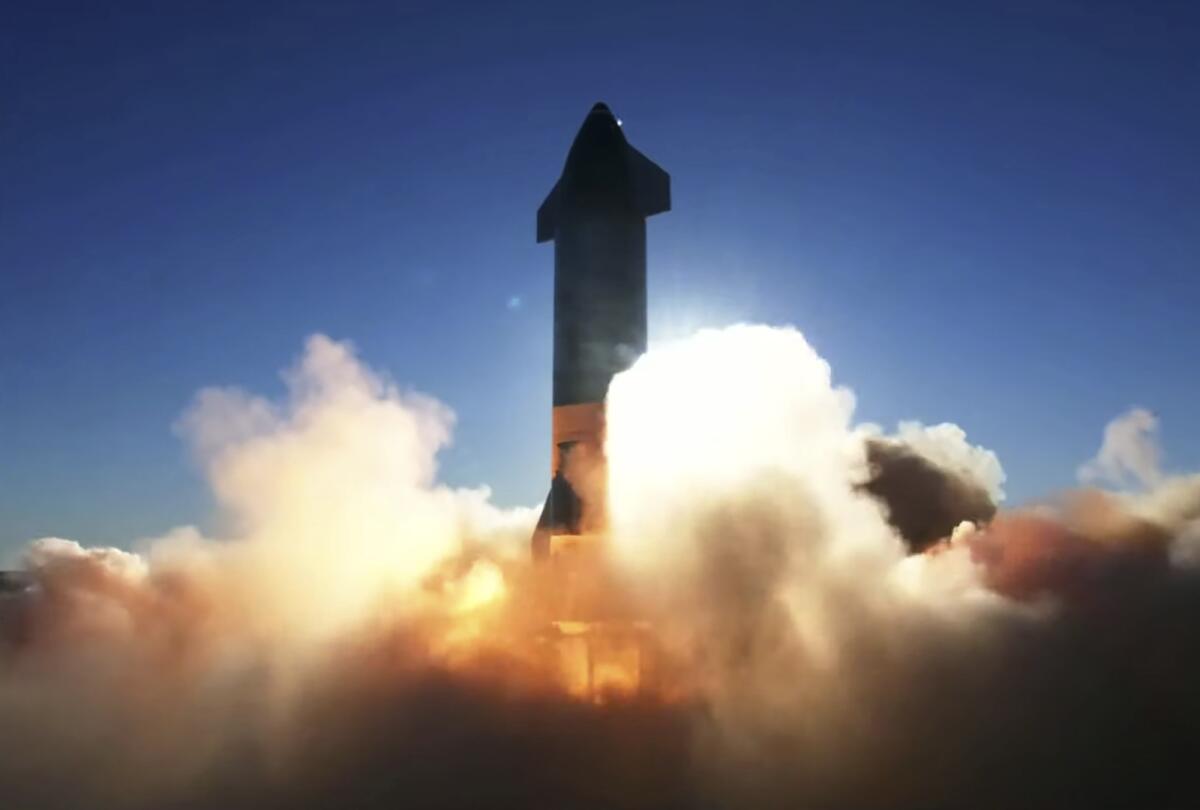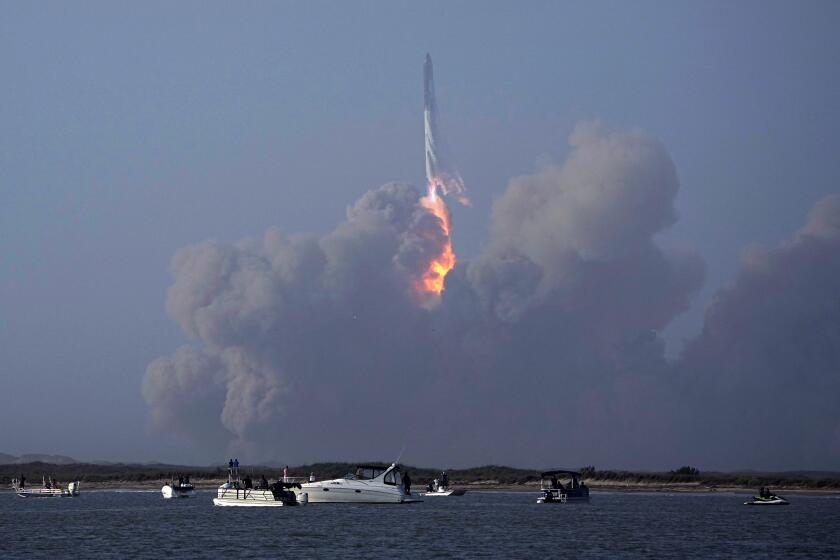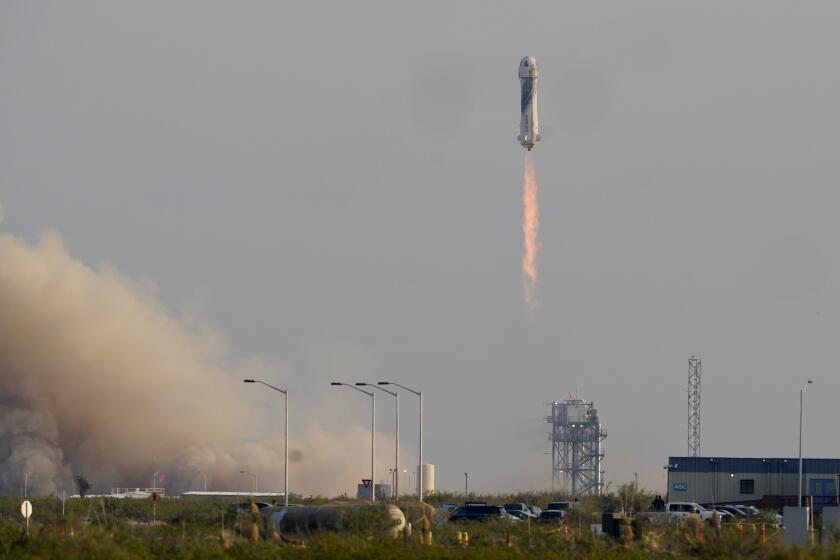The Titanic sub disaster spotlights another extreme venture: space tourism

- Share via
Commercial space travel shares plenty of similarities with deep-sea tourism: wealthy customers, tight spaces, far-flung destinations and waivers that clearly warn people they’re risking death by embarking on unregulated vehicles.
As the world dissects what went wrong with the doomed OceanGate submersible vessel, in which five people died, the craft’s lack of safeguards is raising alarms. The founder of the deep-sea tour group once called safety a “pure waste,” and industry peers flagged the potentially “catastrophic” results of his “experimental” approach to ocean exploration.
Submersibles such as the Titan are subject to little safety oversight, even less so when they’re in international waters. A similar regulatory regime — or lack of one — governs commercial human spaceflight. And although the private space industry hasn’t seen a disaster on the scale of the OceanGate fiasco, the risks are there.
“There’s a strong concern that not having those safety regulations is going to mean some fly-by-night, shady operations that result in customers being injured or potentially killed,” said Brian Weeden, director of program planning for the Secure World Foundation, a space sustainability nonprofit pushing to curb space junk and promote better space traffic management, among other things.
Under current U.S. law, the Federal Aviation Administration can’t impose safety standards on commercial spacecraft that carry people to space. That may change as soon as this year, unless the current law is extended.
SpaceX teams up with tourism firm Space Adventures, saying a Crew Dragon capsule trip could send private citizens even higher into space.
Commercial passengers who strap into a vehicle operated by Elon Musk’s SpaceX, Virgin Galactic Holdings or Blue Origin — the only companies that provide space tourism flights — do so under an “informed consent” framework. That means they acknowledge that the government has not certified the safety of commercial ships and that “participation in space flight may result in death, serious injury or total or partial loss of physical or mental function.”
SpaceX, however, developed its Crew Dragon passenger capsule under NASA’s safety requirements, as the company uses the vehicle to send the agency’s astronauts to the International Space Station.
Virgin Galactic declined to comment, and Blue Origin and SpaceX did not respond to requests for comment.
This informed consent regime began in 2004 with the Commercial Space Launch Amendments Act, which imposed a moratorium on regulation of this area by the FAA for eight years. Congress has twice extended the moratorium, but it expires again in October.
The FAA is taking preliminary action to develop a safety framework for commercial human spaceflight ahead of the moratorium expiring, a spokesperson told Bloomberg News. The agency is also updating its recommended practices for human spaceflight occupant safety and working to develop voluntary consensus standards.
This was the first launch attempt of the company’s massive Starship moon rocket, which is crucial for the future of both SpaceX and U.S. plans for human space exploration.
Rep. Frank D. Lucas (R-Okla.), chair of the House Committee on Science, Space and Technology, said Friday the committee is looking into regulations for commercial space travel but did not provide specifics.
“It’s very important and it’s a growing slice of the industry,” he said. “Let’s see how we work it out.”
The justification for the lack of oversight thus far is that the space industry is still in a learning period, much like commercial aviation in its early years.
“There are those that fear that imposing government safety regulations early in the process is going to stifle the industry,” Weeden said.
The president of the Commercial Spaceflight Federation, an industry group representing commercial space companies that in 2015 lobbied to extend the moratorium, did not respond to a request for comment.
Though the FAA cannot impose safety standards, it is responsible for licensing all space launches and reentries. But it primarily ensures that any associated mishap won’t harm the environment, bystanders and property.
The mechanics of space tourism differ substantially from those of commercial deep-sea exploration. For one, Blue Origin and Virgin Galactic flights aren’t really in danger of being lost during a flight: They don’t achieve orbit, and gravity would swiftly bring them back to Earth. SpaceX sends its ships into orbit, but plenty of tracking technology exists to find space objects if communication breaks down.
Space companies also perform numerous high-profile tests and often emphasize their commitment to safety. Though, the exact protocols and procedures can be somewhat opaque.
Accidents have, however, happened. In July 2021, when Virgin Galactic flew founder Richard Branson into space, the craft deviated from its intended flight path; and in 2014, a pilot died and another was seriously injured during a Virgin Galactic test flight. Just last year, a Blue Origin rocket meant for passengers crashed after its engine failed. No one was on board, and Blue Origin said the flight’s safety measures operated as designed during an emergency.
As space tourism evolves beyond quick trips, some argue it’s time to end the moratorium. SpaceX has already flown 12 commercial astronauts to orbit and the International Space Station. Axiom Space, Vast Space and Blue Origin are also working toward building their own commercial space stations that they want civilians to visit, in some cases, as early as 2025.
The launch of a New Shepard rocket is aborted about a minute into its flight after it apparently suffered an engine problem and veered off course.
Even if the moratorium ends, regulations would take time to draft and implement.
The industry should be proactive, said George Nield, a former associate administrator for commercial space transportation at the FAA.
“I would love to see government, industry, academia all get together and see if we can put together something that everyone would agree to,” said Nield, who is now the president of Commercial Space Technologies. NASA has more than 50 years of experience flying people to space that could be used to inform some safety standards, he said.
If not, a high-profile accident could occur, prompting calls for hasty and heavy regulations.
“That would be very, very bad,” Nield said. “Because fast regulations are generally poor regulations.”
More to Read
Inside the business of entertainment
The Wide Shot brings you news, analysis and insights on everything from streaming wars to production — and what it all means for the future.
You may occasionally receive promotional content from the Los Angeles Times.












